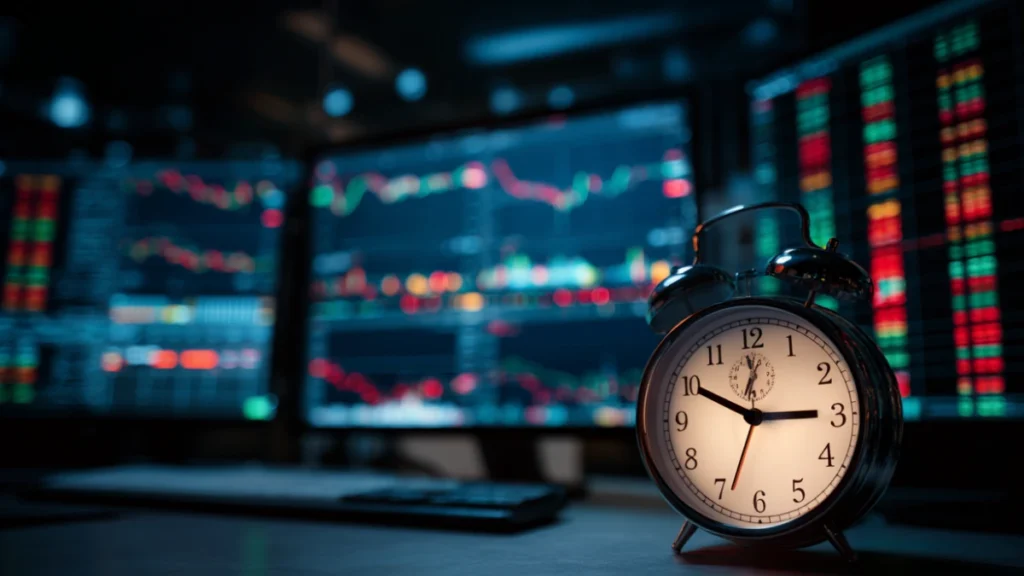Table of Contents
Introduction
Timing is everything in trading — and knowing when to trade can be just as important as what to trade.
Many beginners enter the market at random times, only to wonder why nothing is moving… or why their trade suddenly gets stopped out during a volatile spike. The truth is: every market follows a rhythm, and each trading session comes with its own personality.
In this guide, you’ll discover the major global trading sessions — London, New York, and Asia — and how each one affects price movement, volume, and volatility. You’ll also learn how to match your strategy to the right session, so you’re not trading blindly when the market is asleep.
Whether you trade forex, gold, indices, or crypto, this beginner-friendly breakdown will help you pick the right time to trade — and avoid the quiet hours that kill your edge.
Let’s dive in.
🌍 The 3 Major Trading Sessions (And What Makes Them Unique)
The global financial markets operate 24 hours a day — but that doesn’t mean all hours are equal. Market activity is driven by the opening and closing times of major financial centers, creating three key trading sessions:
- Asian Session (Tokyo)
• Time: 12:00 AM – 8:00 AM UTC
• Markets Active: JPY pairs, AUD, NZD, some crypto activity
• Personality: Calm, low volatility, slower trends
• Best for: Range traders, low-volatility scalping
The Asian session kicks off the trading day with moderate liquidity. It’s generally quieter, making it less ideal for breakout traders — but great for those who thrive in slow, stable markets.
- London Session
• Time: 8:00 AM – 4:00 PM UTC
• Markets Active: GBP, EUR, Gold, indices
• Personality: High volatility, strong trending moves
• Best for: Breakouts, reversals, momentum trading
The London session is the most active session of the day. It overlaps with both Asia (early) and New York (later), creating large moves and deep liquidity. Many prop firm traders focus on this session for precision setups.
- New York Session
• Time: 1:00 PM – 9:00 PM UTC
• Markets Active: USD pairs, Gold, S&P 500, Dow, Nasdaq
• Personality: Fast-paced at open, slower after lunch
• Best for: News trading, high-volume breakouts, reversals
The New York session brings the biggest market players online. The first few hours are fast and volatile, especially during economic news releases. Activity often slows down after 4 PM UTC, making earlier trades more reliable. - 📈 Best Times to Trade Forex, Gold, and Indices (For Beginners)
Each market has its own “sweet spot” — the time when liquidity, volatility, and trade opportunities are at their peak. Knowing when to trade specific instruments can help you avoid false moves and maximize your edge.

💱 Best Time to Trade Forex
• Ideal Window: 8:00 AM – 12:00 PM UTC (London session)
• Why: Major currency pairs like EUR/USD, GBP/USD, and USD/JPY move most during the London and early New York overlap.
• Avoid: Late Asian session or post-5 PM UTC unless scalping or trading news.
Tip: Stick to major pairs and trade during session overlaps for the cleanest trends and tightest spreads.
🪙 Best Time to Trade Gold (XAU/USD)
• Ideal Window: 12:00 PM – 4:00 PM UTC (London–New York overlap)
• Why: Gold reacts strongly to U.S. economic news and volume-driven breakouts, especially around the New York open.
• Avoid: Late New York or early Asian session when momentum dries up.
Tip: Use the London session to identify key levels, and the New York session for execution.
📊 Best Time to Trade Indices (S&P 500, Nasdaq, Dow)
• Ideal Window: 1:30 PM – 4:00 PM UTC (New York open)
• Why: Indices like the S&P 500 explode with volatility at the U.S. market open.
• Avoid: After 6:00 PM UTC when volume fades and price gets choppy.
Tip: Focus on the first 2–3 hours of the U.S. session for breakouts, trend setups, or quick scalps.
🔄 Understanding Session Overlaps — When the Market Moves Fastest
Some of the most explosive trading opportunities happen during session overlaps — when two major markets are active at the same time. This double volume often leads to high momentum, tighter spreads, and clean breakouts.
Let’s break down the two key overlaps:
🔁 London–New York Overlap
• Time: 12:00 PM – 4:00 PM UTC
• Markets Active: USD, EUR, GBP, Gold, Indices
• Why it matters:
o It’s the most volatile time of day
o Major economic news from the U.S. is often released during this window
o Perfect for momentum trades, breakouts, and high-volume setups
This is considered the prime time for most traders — especially those using prop firm accounts. It offers the best mix of liquidity, volume, and price action clarity.
🔁 Asian–London Overlap
• Time: 7:00 AM – 9:00 AM UTC
• Markets Active: JPY, AUD, NZD, early movement in GBP and EUR
• Why it matters:
o Transitional volatility as the London market wakes up
o Can provide early setups before the London surge
o Good for spotting pre-London fakeouts or preparing for breakout entries
This overlap is generally less volatile than the NY overlap, but useful for setting levels and watching price structure evolve.
Knowing when these overlaps occur — and how to adapt your strategy around them — is key to trading with precision instead of randomness.
🧩 Matching Your Trading Style to the Right Session
Not every trading style works well in every session. Some strategies thrive during fast, volatile moves — others need slower, stable markets. Matching your style to the right session is key to avoiding frustration and improving consistency.
⚡ If You’re a Scalper:
• Best sessions: London open (8:00–10:00 AM UTC), New York open (1:30–3:30 PM UTC)
• Why: Tight spreads, high volume, fast intraday swings
• Tip: Focus on momentum bursts and liquidity shifts during major opens or news releases.
📉 If You Trade Breakouts:
• Best sessions: London–New York overlap (12:00–4:00 PM UTC)
• Why: This is when price breaks out of Asian ranges and hits clean moves.
• Tip: Mark Asian session highs/lows and watch for volume surges around them.
🔄 If You Prefer Range or Mean Reversion Trading:
• Best sessions: Late Asian or post-New York (10:00 PM – 6:00 AM UTC)
• Why: Slower movement, less aggressive breakouts
• Tip: Look for consolidations near key levels and fade extremes with tight stops.
🕰️ If You Swing Trade or Trade Higher Timeframes:
• Best sessions: End of day (4:00–8:00 PM UTC) or market open (8:00 AM UTC)
• Why: You’ll catch daily candle closes or fresh market opens — perfect for confirmation
• Tip: Combine session opens with higher timeframe levels and structure.
The more your strategy fits the session, the smoother your trades will feel — and the more confident you’ll be in your setups.
🚫 What to Avoid — Dead Hours, Fake Moves & Common Timing Mistakes
Just like there are ideal times to trade, there are also danger zones — times when the market looks tempting but traps beginners into bad decisions.
Let’s break down the most common timing mistakes and how to avoid them:
😴 Dead Hours (Low Volume)
• Time: After 6:00 PM UTC until Asian session picks up (around 12:00 AM UTC)
• Why to avoid:
o Low liquidity leads to erratic wicks and false signals
o Spreads widen on many pairs
o Your edge weakens due to randomness
Tip: If the market feels slow or “floaty,” step away. Trade when there’s actual participation.
🎭 Fake Moves Before Major Opens
• When: 15–30 minutes before the London or New York session opens
• Why to avoid:
o These moves often reverse sharply once volume kicks in
o They bait traders into early entries without confirmation
Tip: Let the session open fully, wait for volume to confirm direction, then strike.
🧨 Trading During High-Impact News (Without a Plan)
• When: Scheduled economic news (NFP, CPI, FOMC, etc.)
• Why to avoid:
o Spikes can trigger stops instantly
o Slippage and erratic spreads can blow up risk plans
o Market moves aren’t always logical
Tip: Either have a clear news trading plan, or stay flat 15 minutes before and after releases.
💥 Overtrading During Low Volatility
• Why to avoid:
o Choppy markets trick traders into forcing setups
o Overtrading during slow hours leads to poor decisions and emotional trades
Tip: Quality > quantity. One clean trade during a peak session is better than five forced ones after hours.
Mastering when not to trade is just as important as knowing when to enter. Time is a filter — and smart traders only trade when the conditions are right.

🧠 Final Thoughts — Trading Is Not Just About “Where”… It’s About “When”
Most beginners focus all their energy on finding the perfect entry or indicator — but they forget one of the most powerful edges in trading: timing.
Markets move in cycles. Volume rises and falls. Certain hours are full of opportunity… while others are filled with noise, traps, and false hope. If you’re trading at the wrong time, even the best strategy can fail — simply because no one’s participating.
The key is to align your strategy with the right session. Want fast momentum? Trade during the London–New York overlap. Prefer structure and clarity? Focus on session opens. Need more time to think? Swing trade outside of the chaos.
Once you start respecting the rhythm of the market, your trading becomes calmer, clearer, and more consistent.
You don’t need to trade all day to succeed — you just need to trade the right hour with discipline and focus.
Choose your time. Master your timing. And let the market do the rest.
Knowing when to trade can drastically improve your results, but few beginners truly understand the impact of timing on their edge. The markets don’t move randomly — they follow a rhythm dictated by global trading sessions, institutional volume, and economic releases. If you want to improve your precision, you need to study how session timing affects volatility, spreads, and breakout potential. One effective tool used by professionals to monitor market liquidity during sessions is Bookmap, which offers real-time heatmaps to visualize buying and selling pressure.
Whether you’re scalping the S&P 500 during the New York open or swing trading EUR/USD into the London close, aligning your trades with high-volume hours gives your strategy a real advantage. If you’re new to this and also trying to understand technical tools, check out our guide on What Is a Moving Average in Trading? — it’s a great foundation before applying strategies to timed sessions. With the right knowledge, you’ll stop trading in the dark and start capitalizing on the hours that actually matter.

